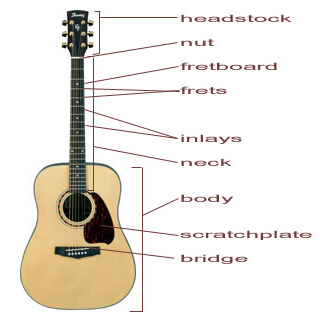diagram (acoustic)
headstock
This the highest part of the guitar, located on the end of the neck of the guitar. It is where the macine heads are located which tighten the strings for tuning. The contained machine heads come in many configurations, for example the more traditional 'three-by-three' with three string tuners on either side of the headstock. There is also the six in a straight line method as seen on the fender stratocaster.
nut
This is a thin strip with grooves cut into it to allow the strings to remain in position on the fret board.
fretboard
This part of the guitar is also called the fingerboard as it is where you finger the chords or notes to be played. It has embedded metal strips across it's top called frets.
frets
These metal strips shorten the string length when a finger is pressed behind them, thereby producing a higher tone.
truss rod
This is a metal rod in the neck of the guitar to control the bend or tension in the guitar's neck. Tightening increases the bend while untightening moves the neck back forward.
inlays
These are the dots commonly found on the freboard, which help the player to quickly identify the exact location of a particular fret. Many guitars use other symbols other that just dots. Inlays are not limited to the fretboard alone, but are any extra decoration added to the exterior of the guitar e.g. a design on the headstock or a intricate piece of art covering the entire exterior of a guitar.
neck
This is the wood on which the fretboard, truss rod, and headstock are connected. It needs to being especially strong when heavy gauge steel strings are used to counteract the forces that try to snap the guitar much like a mouse trap.
strings
Strings are usually plucked with one hand while the other hand presses behind a particular fret or frets to produce a note or chord. The thinner the string the less finger pressure is required to press the string correctly onto the fret and therefore making the guitar easier to play. The thicker the note or the higher the string gauge the harder the guitar is to play.
body
The body of an acoustic guitar contains the sound hole which allows the sound produced by the strings to resonate inside thereby creating the sound amplification. The size of the body directly relates to how loud a sound is produced.
bridge
This piece of a guitar holds the strings in place on the body.
Scratchplate
This protects the finish of a guitar from scratches and from the threat of damage present from when the guitar is being played.


